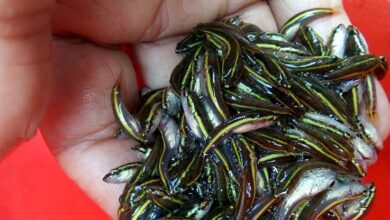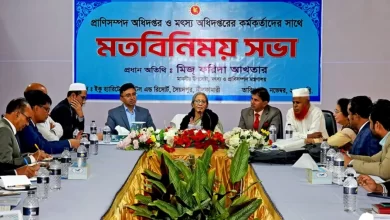In Bangladesh, fish and shrimp are not just food items; they are woven into the country’s culture and economy. However, a longstanding taboo against frozen fish/shrimp has stifled the growth of the local market and prevented consumers from getting their money’s worth. Local people believe that fish and shrimp sold in “frozen” form lack the freshness and quality of those purchased from wet markets. This perception is not only holding the industry back but also putting consumer health at risk, as mishandled fish from these markets often undergoes multiple freeze-thaw cycles that degrade its quality and can lead to health hazards. Today, we will explore how this handling practice negatively impacts the local fish and shrimp market and discuss methods to break this harmful cycle.
In earlier times, Bangladesh’s population was much smaller and the country’s vast network of rivers, estuaries and canals was teeming with fish. The availability of fish was so abundant that local people could rely on fresh catches daily. Fishermen would bring in their haul from nearby water sources and there was no need for long-term storage or preservation techniques. The concept of storing fish for future use was almost foreign, as families could eat freshly caught fish every day without concern. Additionally, freezers were very rare in households before the late 90’s due to limited necessity and accessibility.
However, as Bangladesh’s population grew exponentially—reaching 170 million in just over 148,000 square kilometers— made her the most densely populated country of the world and the country’s landscape began to change. Urbanization took over, with real estate developments filling in many rivers and canals to accommodate the burgeoning population. This rapid, unplanned expansion and different levels of pollution greatly reduced the natural water networks that had once supported local fisheries. With fewer natural sources of fish and the pressures of feeding a much larger population, the traditional reliance on natural raised fish was no longer sustainable. Though the concept of “fresh fish” still remains the same for many generation till now.
Fortunately, during this period of transition, Bangladesh’s aquaculture sector began to flourish. Starting in the 90s, fish farming gained momentum, providing a reliable and controlled alternative to dwindling wild fish stocks. Today, Bangladesh ranks 5th globally in aquaculture production, according to FAO’s State of World Fisheries and Aquaculture 2022.
Although local people were initially reluctant to embrace farm-raised fish and shrimp, as they were accustomed to the taste and quality of wild-caught fishes, they eventually had no choice but to adapt. With the natural sources of fish becoming scarce, farm-raised varieties became the primary option in markets across the country, supplying the growing demand for fishes. Now, most of the fish and shrimp available in markets across Bangladesh are farm-raised, playing a crucial role in meeting the country’s food security needs.
The Journey from Farm to Market: Hidden Dangers
Fish and shrimp in Bangladesh go through a long and often problematic journey before reaching consumers. After being harvested by fishermen or in farms, they are sent to near-by or local wholesale markets, where they may be exposed to improper handling conditions. The fishes are often transported without proper cold chain procedure, which causes it to lose moisture and freshness along the way. Once it arrives at these wholesale markets, ice is applied to preserve the fish and shrimp for transport to larger markets in bigger cities, such as capital city Dhaka, port city Khulna or Chittagong, Sylhet etc.
By the time fish reaches retail shops in large urban areas, it has already gone through significant quality loss. Retailers, eager to sell these products as “fresh,” defrost the frozen or semi-frozen fish to present it in a fresh state. Moreover, rural or city wholesalers, retailers all parties refreeze their unsold stocks to sell them on the next day and this process may repeats until the stock is clear.
Consumers, unaware of this process, purchase what they believe to be fresh fish and shrimp, purchase enough for weeks or month, take them home, cook a portion, and store the rest in their freezers for future use. They later defrost and refreeze the same fish or shrimp, repeating this cycle multiple times until all are cooked.
The Health Risks of Repeated Freezing and Defrosting
The taboo against frozen fish is rooted in the belief that fresh fish is healthier and of better quality. Ironically, this preference for “fresh” fish from wet markets often leads to the consumption of fish that has been repeatedly frozen and defrosted—an unsafe practice that many consumers are unaware of. Every time fish or shrimp is thawed and refrozen, it loses water and nutrients. This results in a product that is less flavorful, less nutritious and even hazardous to health.
The repeated freeze-thaw cycles damage the cell structure of fish and shrimp, making them prone to bacterial contamination. As the product defrosts, bacteria that had been dormant can start to grow, and when it is frozen again, these bacteria remain alive, albeit in a dormant state. If this cycle is repeated, the concentration of bacteria increases, which can lead to foodborne illnesses. Furthermore, some harmful toxins produced by bacteria are heat-resistant, meaning that even cooking may not fully eliminate the risk.
Therefore, buying fish labeled as “fresh” from wet markets may actually expose consumers to greater health risks than purchasing frozen fish, which has been preserved using controlled freezing techniques.
The Impact on the Local Fish and Shrimp Industry
This handling practice doesn’t just affect the health of local people; it also holds back the growth of the local fish and shrimp industry. While Bangladesh is a major exporter of frozen shrimp and fish, domestically, the market for frozen fish is very underdeveloped due to the negative perception surrounding it. This is in stark contrast to international markets, where frozen fish is not only accepted but preferred for its consistency and quality.
Local people, however, continue to pay a premium for so-called fresh fish that has likely undergone improper handling. As a result, they don’t receive the true value for their money. This reluctance to embrace frozen fish hampers the development of the domestic market, which could otherwise be a major driver of economic growth. It also limits opportunities for more sustainable practices in the industry, such as improved refrigeration, reduced food waste, and year-round availability of high-quality fish.
Acceptance of frozen fish can offer substantial financial benefits to the local farmers as well. By freezing their products directly after harvesting, farmers can preserve quality and ensure they receive the right price for their products. This would allow them to avoid the middlemen who often dictate prices in the wholesale markets, helping farmers take greater control over their earnings. Proper freezing techniques would also extend the shelf life of fish and shrimp, allowing them to sell their stock gradually, rather than all at once, which often results in reduced prices.
For retail sellers, frozen products provide a higher level of quality assurance. They can offer their customers fish that has been preserved at its freshest state, avoiding the risks associated with fish that has been improperly handled or thawed multiple times. This will also ensure retailers can secure their investment, as frozen fish can be stored for longer periods without the fear of spoilage, reducing financial losses.
Moreover, as the frozen food market grows, it would spur the development of a new industry focused on the production and sale of freezing equipment. Farmers, wholesalers, and retailers would need to invest in proper freezing infrastructure, leading to a surge in demand for such equipment. This, in turn, would create new business opportunities, foster job creation and contribute to the overall growth of the local economy.
How to Overcome the Frozen Fish Taboo
Shifting consumer perceptions and breaking the cycle of repeated freezing and defrosting will require concerted efforts from both the industry stakeholders and the government. Below are some strategies to address these challenges:
- Educational Campaigns on Freezing Process and Health Risks
A widespread public awareness campaign is necessary to educate consumers about the dangers of repeated freeze-thaw cycles and the benefits of properly frozen fish and shrimp. These campaigns can highlight the scientific facts behind freezing technology, explaining how flash-freezing preserves nutrients and freshness, unlike the improperly handled products from wet markets. This education should also include information on the risks of bacterial contamination from repeated defrosting. - Nutritional Comparisons and Safety Information
Detailed nutritional comparisons between frozen and fresh fish should be made available to consumers. Highlighting that frozen fish retains more nutrients than fish that has been frozen and defrosted multiple times will help dispel the myth that fresh is always better. Safety information about the bacterial risks of repeated freeze-thaw cycles can further solidify the argument in favor of frozen fish. - Certification and Transparency in Supply Chains
Establishing a certification system for frozen fish and shrimp can help build consumer trust. Labels such as “Frozen at Peak Freshness” or “Single-Freezing Guaranteed” can assure consumers that the product they are buying has undergone only one freeze cycle, preserving its quality and safety. Furthermore, transparency in the supply chain, from catch to market, will help improve consumer confidence in frozen fish. Government FIQC (Fisheries Inspection and Quality Control) dept and industry stakeholder can cooperate to make it possible. - Endorsement by Local Influencers and Health Experts
Engaging prominent local figures such as chefs, nutritionists, sportsman and health experts to promote frozen fish can help shift perceptions. These influencers can share recipes and cooking techniques that showcase how delicious and nutritious frozen fish and shrimp can be. This will also help normalize the consumption of frozen fish in everyday Bangladeshi cuisine. - Improved Retail Practices
Retailers play a crucial role in changing consumer habits. They should be trained in proper storage and handling of frozen fish/shrimp to maintain its quality. Encouraging them to sell frozen products as frozen, rather than defrosting them to appear fresh, will ensure better quality and safety for consumers. - Proper forms & Packaging
Introducing various forms, cuts and packaging options for frozen fish and shrimp could significantly benefit busy urban consumers. Such as, IQF (Individual Quick Frozen) products, like shrimp or small fish, people can use only the quantity they need without defrosting the entire package, offering flexibility and reducing waste. Additionally, providing fish and shrimp in pre-cut or ready-to-cook formats would simplify meal preparation, catering to the fast-paced lifestyles of city dwellers. This approach combines convenience, practicality and quality, making frozen fish a more appealing option for everyday use. - Tasting Events and Promotions
Organizing taste tests and cooking demonstrations can help prove that frozen fish is just as flavorful and versatile as fresh fish. Promotional discounts and offers can incentivize consumers to try frozen fish, leading to greater acceptance.
The “frozen fish” taboo is not just a cultural hurdle—it is a significant public health concern and an economic impediment. By continuing to reject frozen fish, local people are unknowingly consuming lower-quality, less nutritious and potentially harmful products. Embracing frozen fish could also benefit the entire aquaculture industry by attracting more investment and promoting sustainable development. With the infrastructure in place for freezing, the industry would be better equipped to meet both domestic and export demands year-round.
This would also encourage sustainable farming practices, as farmers would no longer be pressured to harvest all their stock at once to meet short-term market demand. A more stable, year-round market for fish and shrimp would lead to a more secure and profitable industry for everyone involved.
Changing these perceptions will take time, but with education, better industry practices and influencer support, Bangladesh can build a thriving market for frozen fish and shrimp, benefiting both the economy and consumer health.





